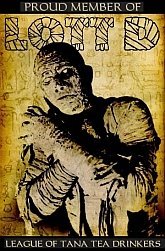Zombos Says: Very Good
Is the following fact or fiction? Two young movie makers use a desktop PC and less than nine hundred dollars to produce the first all-digital documentary-styled horror film in 1998?
It's fact. A few months before The Blair Witch Project brought documentary style horror to the forefront, The Last Broadcast presented a chilling account of three bloody murders that happened one cold night in the Pine Barrens of New Jersey. Beginning as a fictitious documentary about the Jersey Devil Murders using salvaged video footage, interviews, and police evidence, the film's twist ending reveals the real murderer--or does it?
Using Photoshop to enhance scenes, consumer-grade video recorders, and lots of post-production doctoring on a desktop PC, Stefan Avalos and Lance Weiler digitally composed their thriller using mostly non-actors, Weiler's mom, and anything not nailed down. The final product is an eerie, slow-building, story that takes a sudden left turn to reveal the true murderer. According to the audio commentary on the DVD, seven clues are in the film pointing to the murderer. I missed all seven.
Technology plays an important part within the film itself, first as visual and auditory information is manipulated to create the pseudo-documentary structure of the film, and then as impetus for the events within it.

The film begins as a probing documentary by director David Leigh (played with aplomb by David Beard), who asks the question, "Did Jim Suerd commit the murders?" The profile of Suerd--troubled childhood, a loner, and computer nerd fascinated by the Internet and magic tricks--points to an unstable individual who may be capable of cold-blooded murder. But the film leaves you wondering who the documentary was really about.
 Fact or Fiction is a public-access cable show hosted by two it's-always-Saturday hosts (think Wayne's World here)--Avkast and Wheeler, who are searching for a way to keep their show on the air (although they do sell a lot of t-shirts). Initially a kitschy hit about two slackers discussing weird stuff, the topics are getting stale and its popularity is waning.
Fact or Fiction is a public-access cable show hosted by two it's-always-Saturday hosts (think Wayne's World here)--Avkast and Wheeler, who are searching for a way to keep their show on the air (although they do sell a lot of t-shirts). Initially a kitschy hit about two slackers discussing weird stuff, the topics are getting stale and its popularity is waning.
Looking for any hook to bring back viewers, the hosts turn to Internet Relay Chat so viewers can send suggestions for what the show should investigate next. One suggestion, to do a live show from the Pine Barrens of Southern New Jersey in search of the Jersey Devil, the legendary creature who inspired the name of the New Jersey Devils ice hockey team, intrigues the show's hosts, and soon has them assembling a crew to investigate.
 The crew is comprised of Jim Suerd, a fan of the show and self-professed psychic, and Rein Clackin, audio technician. Suerd is the odd one--oddest one--of the bunch. He's not quite fully in the here and now. Avkast and Wheeler use him as a psychic bloodhound to lead them deep into the woods of the Pine Barrens in search of the best spot to see the Jersey Devil.
The crew is comprised of Jim Suerd, a fan of the show and self-professed psychic, and Rein Clackin, audio technician. Suerd is the odd one--oddest one--of the bunch. He's not quite fully in the here and now. Avkast and Wheeler use him as a psychic bloodhound to lead them deep into the woods of the Pine Barrens in search of the best spot to see the Jersey Devil.
As the documentary unfolds, a reenactment of the trip is shown using video footage shot by Avkast and Wheeler: they recruit the team members and focus on Suerd, who goes into a psychic fit. As the team assembles and preparations are made, the documentary moves to the fifteen hours of recovered footage from the ill-fated night in the woods. In the now familiar cinema verite style of shaky close-ups, scene ambiguity, and quick-cut action snippets, Avkast, Wheeler, Suerd and Clackin are shown trying to find a suitable location for camp, bitching about this or that, and suddenly finding they are not alone in the very cold, very dark Pine Barrens.
Enough is shown or intimated to give you a nice creepy feeling. Throughout it all, director David Leigh's stoic voice intones the police evidence for arresting and convicting Suerd, the lone survivor, then asks questions about the assumed guilt of Jim Suerd. Just when you think the answers are going to remain unclear, the film shifts from documentary perspective to third-person, and follows the restoration of a critical piece of video that may show the killer's face, and the dedicated forensic video technician working to make it happen. The denouement leaves no doubt as to who the killer is. In a sudden and very brutal scene the killer is revealed.
 What stands out are the performances by the non-actors involved, especially Weiler's mom. They do a credible job creating an air of authenticity for the documentary. The slow pacing is mitigated by the interesting characters, their backstories, and the shift from the documentary investigating Suerd to the reenactment of the trip, then to the recovered video footage. The twist ending, in both its shift in perspective and sudden revelation, is a bold move. The final scene returns us to the Pine Barrens and leaves you with uncertainty and bewilderment. The Last Broadcast is a worthy entry in the cinema of horror.
What stands out are the performances by the non-actors involved, especially Weiler's mom. They do a credible job creating an air of authenticity for the documentary. The slow pacing is mitigated by the interesting characters, their backstories, and the shift from the documentary investigating Suerd to the reenactment of the trip, then to the recovered video footage. The twist ending, in both its shift in perspective and sudden revelation, is a bold move. The final scene returns us to the Pine Barrens and leaves you with uncertainty and bewilderment. The Last Broadcast is a worthy entry in the cinema of horror.
The Heretic DVD:
Three short featurettes stand out in particular: the Pre-production, Post-production, and Distribution discussions by Avalos and Weiler are lively and enlightening. In Pre-production, they talk about their discovery of the actor to play Suerd (Jim Seward) in the aisle of a video store, and how they lighted scenes using Chinese Lanterns to create a soft light that could be manipulated according to the wattage used. In Post-production, they discuss their extensive use of Photoshop to add gore effects to scenes, and how they composed the various police evidence used in the documentary on their PC. In Distribution, a very interesting discussion of how they fought to remain purely digital presages the current state of digital film distribution.
Two audio commentaries, one from 1998 and another for this release add to a well thought out presentation, as well as an entertaining mini-comic.









